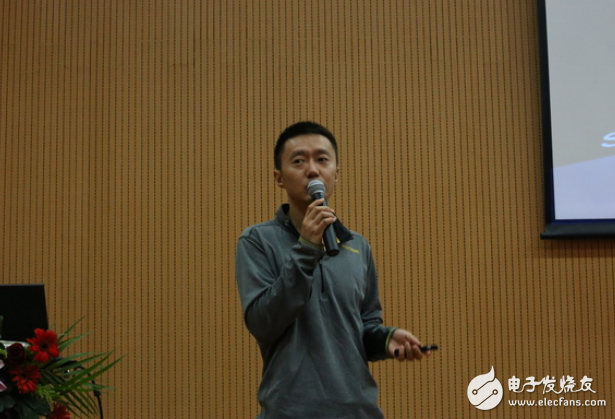The popularity of the Internet of Things market, in addition to direct benefits to chip vendors, component manufacturers, system integrators and terminal manufacturers, can also bring new opportunities to EDA tool vendors. At the "China IoT Conference" hosted by Huaqiang Jufeng Electronic Enthusiast, the electronic enthusiast editor and the industry-leading EDA tool manufacturer Synopsys' processor IP and tools Asia Pacific senior product program manager Mr. Yin Luosheng had an in-depth conversation to discuss EDA tools. Opportunities and challenges for vendors under the Internet of Things.
Power consumption and cost are key
Due to the particularity of its application, IoT products are often powered by lithium batteries or button batteries, and because most products of the Internet of Things are relatively small in size, they limit the capacity of lithium batteries, etc. In terms of products, how to reduce power consumption has become a key concern. In addition to the screen, the most power-hungry module comes to the main control chip. How chip manufacturers do power control in the process of chip design becomes an issue that needs to be considered.
Manager Yin also believes that for the Internet of Things, low power consumption is the most fundamental requirement.
"Synopsys, a manufacturer of chip design tools, has extensive experience in reducing chip design power. Synopsys offers software-to-silicon and verification solutions to create energy-optimized chips," said Yin.
In addition to power consumption, the cost of the chip is also the focus of IC design vendors.
According to Manager Yin, the cost of the intermediate design from a chip to the IP core license, to the design, the film, and the final shipment process is very large, if there is any problem in the development cycle of the IC developer. May cause huge losses.
Taking these issues into consideration, Synopsys worked with different wafer vendors to help IC designers advance chip implementations based on different IoT processes, helping IC designers meet their product requirements in terms of chip area and power consumption.

Synopsys Senior Product Solutions Manager Yin Luosheng
IP core helps the Internet of Things
Synopsys is known for its EDA tools, but after years of development, it has a deep knowledge of the core of the chip, the IP core, and has achieved good results.
Manager Yin said that Synopsys' revenue on the IP core has reached 400 million US dollars last year. Among them, Synopsys is the ARC processor with very low power, very small size and higher program density. Among them, ARC EM4 is at the leading level in the industry with a speed of 410 DMIPS at 12.9uW/MHz. ARC processors are also widely used in computers, SSDs, memories, etc., and have achieved good sales. Last year, ARC ranked second in the global "selling processors", and ARC's market share reached 20%. This low-power product is the best choice for the Internet of Things.
In addition, for the needs of the Internet of Things, Synopsys simplifies the traditional SoC to introduce the "Bus-Less" architecture, physically shortening the interface to processor distance. A dozens of times to reduce power consumption, Cycle count is also reduced by 90%. Unlike typical multi-layer bus processor systems, the Bus-less architecture eliminates Memory and replaces it with DCCM, which allows the CPU to reach Memory directly without sharing the bus with other modules.
In addition to starting from the above two aspects, Synopsys also brought its advanced experience to China.
Manager Yin pointed out that in recent years, Chinese chip design companies have sprung up in the international market, and it is not unrelated to bring advanced experience accumulated by vendors such as Synopsys to China. He also stressed that if there is still a gap between the chip design of Chinese chip makers and the internationally renowned fabless designers at 55nm or 28nm, the latest 7nm or smaller process chip designs, Chinese manufacturers and foreign countries. The gap is not very obvious. These advanced design techniques have a wealth of experience for the design of IoT chips. Even though IoT chips do not require such advanced processes, they can be used for design.
Finally, Manager Yin also stressed that in addition to providing EDA tools and IP and chip vendors in the IoT, Synopsys also hopes to cooperate with system integrators and participants in the IoT industry chain to create a mature ecosystem and connect the Internet of Things. Advance from a fragmented application to a mature market. This is the vision of Synopsys and our expectation.
Iphone Lightning Cable with Lightning Connector Sync and charge your iPhone, iPad, or iPod with faster speed.
The Iphone Charger Cable could meets your need for any place . Its length contains 3tf , 6ft , 10ft , etc .
Our customers and the media all agree on one thing: this cable is one of the best iPhone Lightning cables in the world.
This iPhone charger cable boasts increased durability, faster charging, faster data transfer and compatibility with almost all cases. Give your iPhone the treatment it deserves.
iPhone Lightning Cable compatible with IOS devices that have a Lightning port, including iPhone 8 /7 / 6 / 6s,iPhone 8 Plus / 7 Plus / 6 Plus / 6s Plus, iPhone 5 / 5C / 5S, iPad with Retina display, For iPad mini, iPad Air, iPad Pro, iPod nano 7th Gen and iPod touch 6th Generation.
The iPhone charger cable which with Original 8 Pin connector with a lightning end has lightning-fast data transfer , retro comfortable, soft and elastic,strong, durable ,dirt , no deformation.
We are committed to providing professional, safe and stable mobile powers for our customers .
Iphone Lightning Cable
Iphone Lightning Cable,Iphone Charger Cable,Iphone 6 Charger Cable,Long Iphone Lightning Cable,Apple Iphone Charger Cable,Iphone Usb Cable
Hebei Baisiwei Import&Export Trade Co., LTD. , https://www.baisiweicable.com
